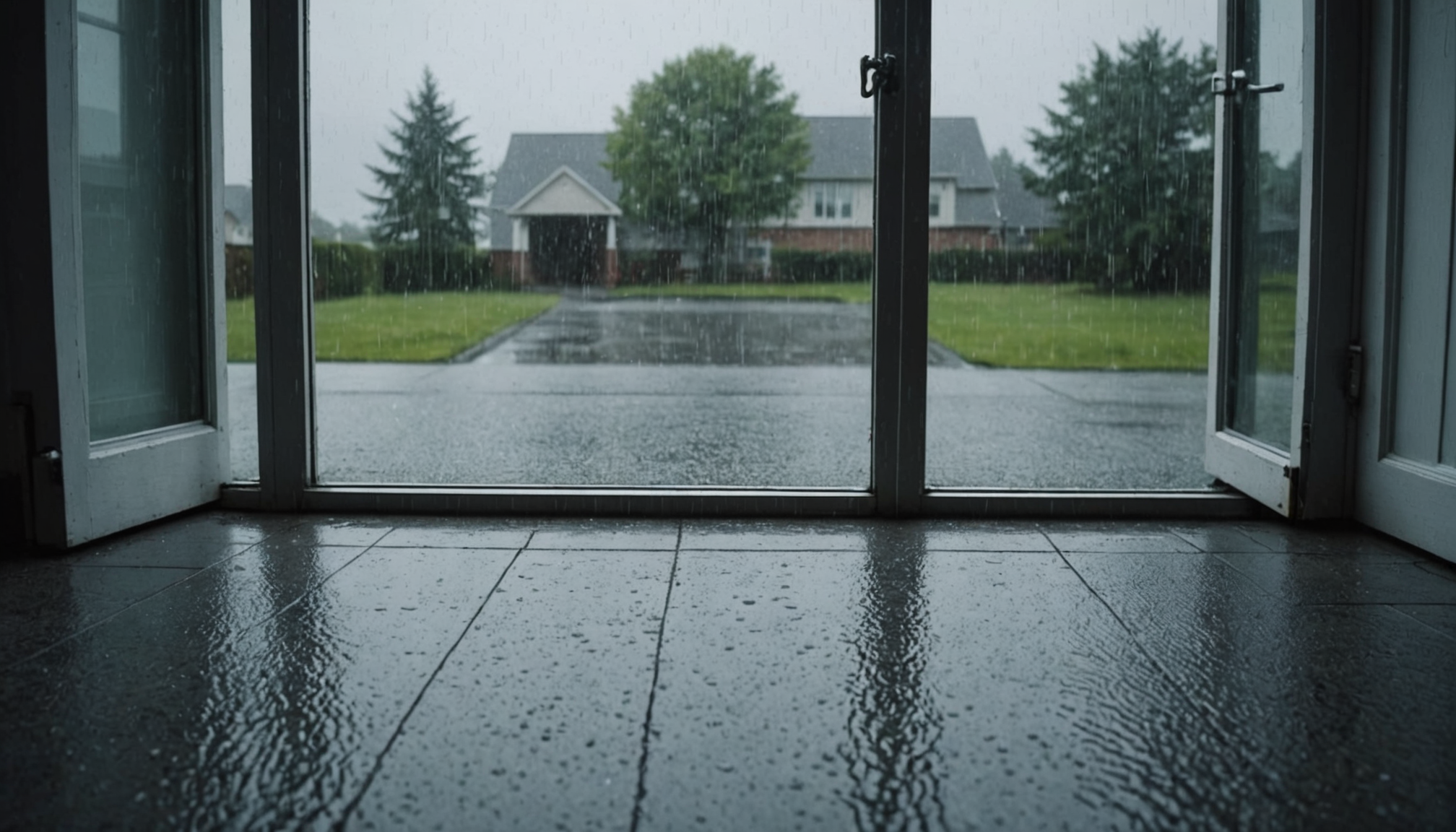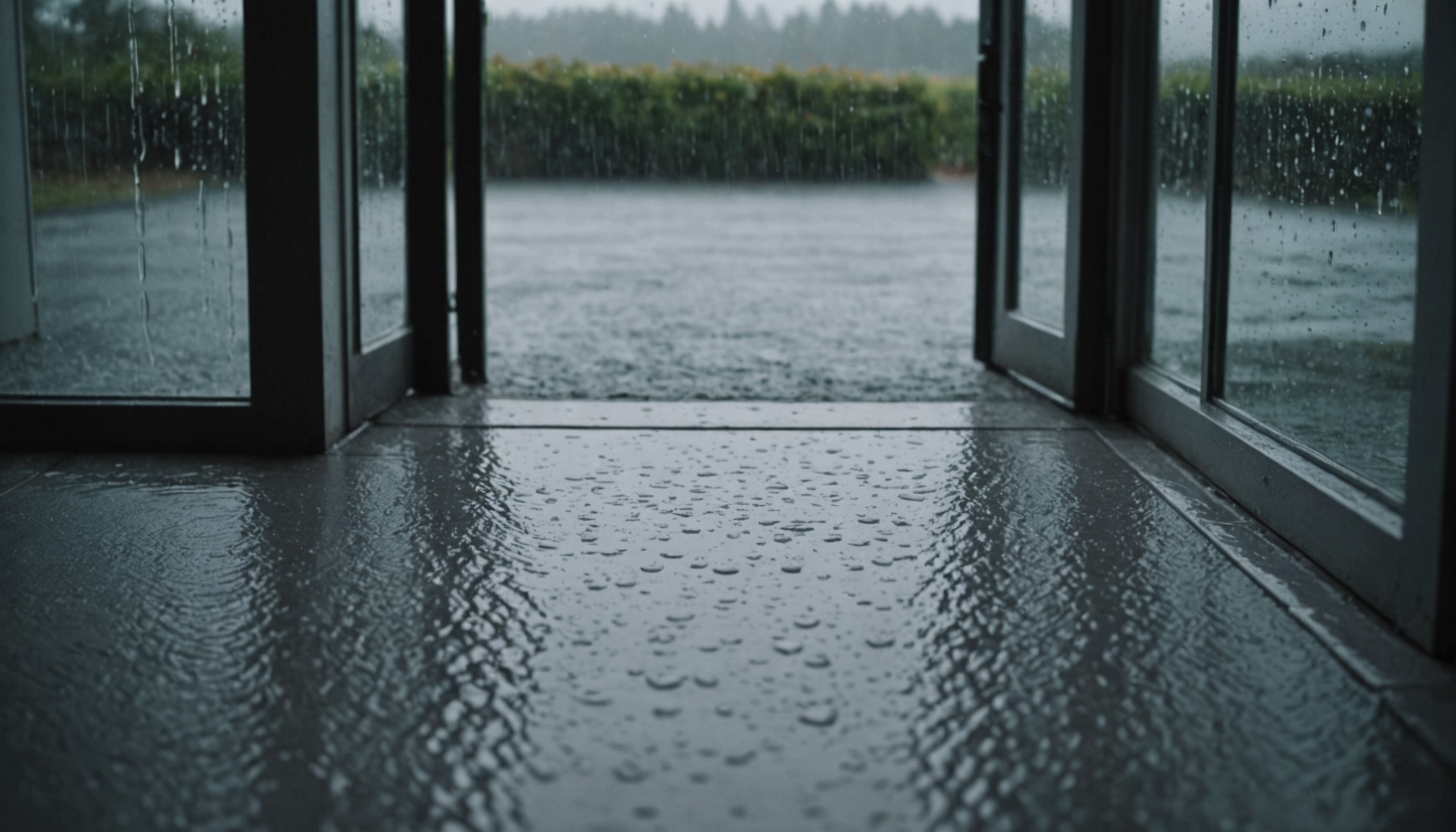Maintaining the integrity of your home’s entryways is more than just a matter of aesthetics; it’s crucial for safeguarding against energy loss and moisture intrusion. However, an exterior door threshold that leaks can quickly compromise these advantages, particularly during periods of heavy rainfall common to the St. Louis area. For homeowners looking to protect their homes, understanding the typical causes of such leaks is a fundamental first step. By identifying these issues early on, you can take more effective action to preserve your home’s structure and indoor environment.
Most door threshold leaks can be traced back to a few common culprits. Environmental factors, such as the frequent and intense rain common to the St. Louis region, play a significant role in exacerbating existing vulnerabilities in exterior door installations. Furthermore, incorrect installation, wear and tear, and inadequate sealing can all contribute to the problem. Understanding the interplay of these elements can help homeowners pinpoint the root of their issues and make informed choices about repairs and preventative measures.
One prevalent cause is improper installation. If a door threshold isn’t aligned correctly or lacks adequate clearances, it often leads to water pooling and eventual seepage. Such installation errors are frequently observed in DIY efforts or when contractors cut
Assessing the damage and identifying problem areas
When dealing with exterior door threshold leaks, assessing the damage is a crucial step that allows homeowners in St. Louis to address the problem effectively. Begin by conducting a thorough inspection, focusing on the immediate area around the door threshold. During periods of heavy rainfall, water stains or visible dampness around the door’s edges can indicate water intrusion points. Additionally, check for signs of rot or mold, as these can signal prolonged exposure to moisture and require immediate attention.
Next, examine the integrity of the weatherproofing materials, such as seals and gaskets. These components are often overlooked but play a vital role in preventing leaks. Over time, exposure to the elements can cause seals to degrade, leading to ineffective barriers against aggressive St. Louis weather. By identifying worn or compromised seals, you can determine targeted repair or replacement strategies.
It’s also essential to inspect the structure of the threshold itself. Look for any cracks or separation from the surrounding frame, as these can be pathways for water entry. Structural shifts, often resulting from foundation settling or repeated exposure to moisture, can loosen the threshold, amplifying the likelihood of leaks. Understanding these underlying causes will guide the selection of appropriate materials and techniques for a successful repair.
- Perform a detailed inspection of the door threshold during or shortly after rainfall to identify water seepage areas.
- Check for visible signs of rot or mold around the door frame, as these indicate prolonged exposure to leaks.
- Evaluate the condition of seals and gaskets, replacing any that show signs of wear or damage.
- Inspect the structural integrity of the threshold for cracks or separations that could allow water penetration.
- Consider the possibility of foundation shifts or structural issues that may have caused the threshold to loosen or misalign.
Effective sealing techniques for wet weather
When addressing leaks in exterior door thresholds, especially in a rain-prone city like St. Louis, employing effective sealing techniques is vital. Homeowners often make common mistakes when trying to seal these leaks, but with some careful consideration, these errors can be avoided.
One frequent error is using the wrong type of caulking. Many people default to using general-purpose caulk, which may not withstand the harsh weather conditions typical to the St. Louis area. Instead, opt for a high-quality, weatherproof sealant specifically designed for exterior use. These products are formulated to handle the expansion and contraction caused by temperature changes, ensuring a durable seal.
Another common mistake is applying sealant over dirty or wet surfaces. To ensure proper adhesion, always clean the threshold area before application. This includes removing old caulk, dirt, and debris, and allowing the surface to dry completely. Failing to do so could result in a poor bond and future leaks.
A less obvious, yet crucial, detail often overlooked is the application of sealant in the wrong areas. While it’s tempting to seal every visible gap, be aware that some openings are intentionally designed to allow controlled drainage. Sealing these can create unintended pressure build-up and direct water to unwanted locations, exacerbating the problem. Carefully examine manufacturer guidelines for specific areas that should remain unsealed.
More so, homeowners sometimes overlook the importance of reapplying sealant periodically. Even the best products degrade over time, particularly in the demanding St. Louis climate. Regular maintenance every couple of years will help avoid recurrent leaks.
Lastly, improper preparation or complete omission of primer before sealing can also lead to unsuccessful results. High-adherence primers enhance the bond between the threshold and sealant, especially on surfaces like metal or concrete. Using an appropriate primer ensures a longer-lasting solution.
To remedy these errors, pay close attention to product selection, thorough cleaning and drying of the surface, adherence to sealing guidelines, regular maintenance, and proper preparation before sealing. These strategic steps can make a significant difference in keeping your door thresholds leak-free, even during the heaviest of St. Louis rains.
Selecting appropriate materials for repair
Choosing the right materials for repairing door threshold leaks is vital to ensure lasting durability and performance, especially against the backdrop of St. Louis’s notorious wet weather. Selecting materials that can withstand the local climate while effectively preventing water intrusion requires both understanding and foresight.
First, prioritize materials that are labeled as weatherproof. Weatherproofing products are designed to endure extended exposure to elements such as rain, wind, and fluctuating temperatures. For thresholds, using weatherproof seals and gaskets is critical. These components serve as the front line of defense against water ingress and should be robust enough to endure continuous changes in temperature and humidity.
For the door threshold itself, consider materials like rot-resistant hardwoods or composite materials. Options such as teak, cedar, or PVC are renowned for their ability to resist water damage and mold growth. Composite thresholds, in particular, offer superior resistance to warping and are less prone to degradation over time compared to traditional wood.
If the repair involves sealing or caulking, opt for a high-quality, silicone-based sealant. Silicone sealants provide exceptional flexibility, allowing them to expand and contract with changes in temperature without losing adhesion or cracking. This flexibility is essential for ensuring a long-lasting seal that can endure the severe weather patterns specific to St. Louis.
For securing thresholds, use fasteners that resist corrosion, such as stainless steel or galvanized screws. These materials are less likely to rust when exposed to moisture, ensuring the threshold remains securely anchored over time. Likewise, using a bonding adhesive with excellent water resistance properties will reinforce the assembly and prevent premature failure of components.
Finally, when selecting materials, also consider ease of maintenance and cost-effectiveness. While premium grade materials may have a higher up-front cost, their longevity and reduced need for frequent repairs can be more economical. The aim is to choose materials that not only offer immediate solutions to threshold leaks but also contribute to the long-term protection and value of your home.
By taking these insights into account, you set the stage for successes, transforming repair challenges into enhanced protection for your home. Be empowered by your choices, knowing that each decision you make prepares your home to weather even the toughest St. Louis storms. With diligence and the right materials, you can confidently face the inclement weather, knowing your doors are ready to stand the test of time.
Preventative measures for long-term protection
For homeowners in areas like St. Louis, where rain and unpredictable weather are common, implementing preventative measures is essential to ensuring long-term protection against door threshold leaks. Regular maintenance and proactive steps can significantly reduce the likelihood of leaks, preserving both the structural integrity and aesthetic appeal of your home.
Begin by establishing a routine inspection schedule to check for early signs of wear or damage. Regularly examine the condition of weatherproofing materials such as seals and gaskets. These components serve as primary barriers against water intrusion, and their timely replacement or reinforcement can avert potential leaks before they occur.
Additionally, consider applying a water-repellent finish to the exterior of your doors and thresholds. This protective coating enhances the resilience of the door surface and threshold against excessive moisture, further minimizing the risk of water seepage. Ensure that the selected product is compatible with the existing materials and designed for the specific environmental conditions of St. Louis.
Proper drainage around your home’s entryways is another critical aspect. Ensure that the ground and landscaping around door thresholds slope away from the house to direct water flow outward, reducing accumulation near the entryway. Installing or maintaining gutter systems also helps to manage roof runoff effectively rather than allowing it to cascade over doorways, potentially compromising the thresholds below.
For those considering larger upgrades, investing in a porch cover or awning can provide added protection by shielding your doors from direct rainfall, thereby decreasing the amount of water that can accumulate around the thresholds.
Finally, educate yourself about your door and threshold warranty terms and conditions. Some manufacturers offer maintenance guidelines and recommendations specific to their products, which can help prolong their efficacy and lifespan. Following these guidelines ensures that any necessary repairs or maintenance routines adhere to recommended practices, providing ongoing assurance against leaks and damage.
By implementing these preventative strategies, homeowners can keep their doors and thresholds in optimal condition, ensuring that the pesky leaks remain at bay despite the challenges posed by St. Louis’s frequent wet weather.
- Why does my door threshold keep leaking even after repairs?
- Persistent leaks may indicate that underlying issues were not fully addressed during the repair. It’s crucial to assess all potential problem areas, including the threshold’s structural alignment, seal integrity, and drainage around the entryway. Consulting a professional can help identify any overlooked issues.
- What’s the best type of sealant for exterior door thresholds?
- For exterior door thresholds exposed to wet weather, a high-quality, silicone-based sealant is recommended. Silicone offers excellent flexibility and durability, allowing it to withstand temperature variations and maintain a strong bond, making it ideal for St. Louis’s climate.
- How often should I check my door thresholds for leaks?
- It’s advisable to inspect your door thresholds at least twice a year, ideally before and after the wet season. Regular checks help identify wear and potential leaks early, allowing for prompt action to prevent more extensive damage.
- Can I install new weatherproofing materials myself?
- Yes, many weatherproofing tasks, such as replacing seals or gaskets, can be done independently with the correct tools and materials. Ensure you’re familiar with the installation process, and do so during dry conditions to achieve the best results. However, for complex issues, professional assistance may be necessary.
- What can I do to prevent foundation shifts from affecting my doors?
- Consistent monitoring and maintenance of your home’s foundation are key. Address drainage issues that can lead to soil erosion or uneven settling, and routinely inspect for signs of foundation movement. Hiring a structural engineer for a periodic assessment can provide peace of mind and early detection of potential problems.

